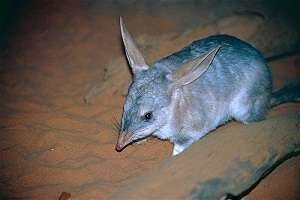Bilby burrows integral to ecosystem function

Abandoned bilby burrows on rangeland restoration sites at Lorna Glen are proving to have multiple benefits for the landscape.
Bilbies (Macrotis lagotis) being prolific foragers and diggers, play a pivotal role in arid and resource-scarce environments by creating burrows which can improve soil microclimates.
The study by Department of Parks and Wildlife's (DPaW) Fauna Conservation Program found the burrows acted like regulators to temperature and humidity in the arid and barren climate.
"The more moderate and stable microclimate in the burrows at night may provide two potential benefits," DPaW research scientist Dr Tamra Chapman says.
"Firstly, other fauna seeking to use the burrows for nocturnal refuges and feeding habitats might be favoured by the lower energetic costs of thermoregulation and foraging.
"Secondly, seeds in the burrows and on the surface soil of the control micro sites would be subject to different temperature and humidity regimes while stored in the seed bank and during germination, which may increase plant diversity, " Dr Chapman says.
The study was conducted at Pink Lake on bilby burrows that were abandoned shortly after being dug, giving Dr Chapman an opportunity to unobtrusively investigate their impact.
The inside of the relic burrows were higher in soil moisture, pH, exchangeable magnesium, exchangeable potassium, mineral nitrogen, total cation exchange capacity, and significantly lower in bio-available aluminium than the surrounding soil.
The results also revealed an accumulation of mineral nitrogen in the burrows—an element particularly scarce in rangeland environments but likely helpful for arid-zone plant growth.
Given that bilbies do not defecate inside their burrows, soil mineral nitrogen could have been increased by the Birch effect—an increase in mineral nitrogen observed after periods of drying and rewetting of soil in arid climates.
However, "the role of humidity [inside the burrow] in this process is beyond the scope of this study, but it may be hypothesised that the mineralisation of nitrogen would be enhanced by the relatively favourable microclimate in the burrows," Dr Chapman says.
Dr Chapman says nitrogen accumulation can be achieved by furrowing activity and the reintroduction of soil-modifying fauna like bilbies would increase this.
"Reintroducing bilbies not only restores our natural heritage but, as this and other studies have shown, may also restore our ecosystems, by moderating micro-climate conditions and increasing resource availability, thereby creating more suitable habitats for the establishment and productivity of other species."
Both of these scenarios, if applicable at Lorna Glen, would contribute to ecosystem productivity and potentially, restoration.
Provided by Science Network WA

















